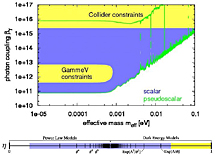- Number 327 |
- December 20, 2010
Chasing chameleons
Scientists at DOE’s Fermi National Accelerator Laboratory report new experimental constraints on a theoretical model that tries to explain the origin of dark energy, the mysterious force that accelerates the expansion of our universe.
According to the chameleon model, dark energy stems from particles that change their mass depending upon the local environment. In the presence of ordinary matter, chameleons are massive particles that mediate a short-range force – too short to have appeared in searches for new forces. But in the vacuum of space, chameleons would have small masses. In principle, chameleons would interact with electromagnetic fields and, under certain conditions, could create photons, and photons could create chameleons.
Scientists of the Chameleon Afterglow Search (CHASE) explore this possibility by shining a laser beam into a vacuum chamber located inside a long, strong magnet. Traversing the magnetic field, the laser light might produce a population of chameleon particles within the chamber. When the laser is turned off, the chameleons would continue to interact with the magnetic field and produce an observable afterglow of photons.
No chameleon afterglow signal was seen in the CHASE data, which allowed the collaboration to place more stringent limits on chameleon models of dark energy. The new limits span a range of nearly four orders of magnitude in chameleon mass (see graphic) and are nearly five orders of magnitude more stringent than previous bounds from particle collider experiments. The results are available in the arXiv preprint server and will soon appear in Physical Review Letters.
[Kurt Riesselmann, 630.840.3351,
kurtr@fnal.gov]

